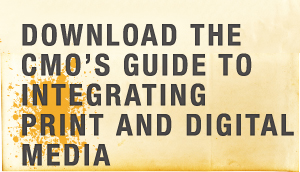As we start the new year, marketers have even more options than ever before in regards to how and where to promote their business. Besides traditional channels like direct marketing and print ads, there’s email marketing, mobile marketing, banner ads and social media channels such as Facebook and Twitter.
With so many of your target audience members engaging across the wide, media spectrum, it’s no longer feasible to run an entire campaign on one channel. Integrated marketing campaigns offer better reach and allow you to craft messaging for specific channels your customers prefer.
While there is no one-size-fits-all approach to creating integrated campaigns, as each brand will have different goals and budgets, there are specific steps every marketer should follow to ensure the greatest success.
Step 1: Know Your Target Audience
 You’ve got to know your audience inside and out to be successful with any marketing tactics, specifically within an integrated approach. Understand who they are demographically (age, gender, education) as well as psychographically (behavior, attitudes, interests). This information will help you choose the right channels and develop effective messaging.
You’ve got to know your audience inside and out to be successful with any marketing tactics, specifically within an integrated approach. Understand who they are demographically (age, gender, education) as well as psychographically (behavior, attitudes, interests). This information will help you choose the right channels and develop effective messaging.
Determining what your prospects motivations are, how they like being communicated with, which sites they visit regularly and magazines they peruse, and what their questions and pain points are is a crucial first step to developing a successful integrated campaign.
Step 2: Select Your Channels
Don’t pollute your marketing efforts by selecting 12 channels when you could have equal or greater success with only 4. If your target audience isn’t on Facebook, then don’t bother with Facebook just because social media gurus tell you you HAVE to be on there.
After you have determined which channels your customers currently use, you’ll have to consider the channels’ strengths and weaknesses. Be certain they will be able to help you reach your business objectives. Again, don’t sink ad dollars and time into channels that aren’t going to be effective or give you the ROI you’re looking for.
Step 3: Pay Attention to Brand Consistency
While messaging should be tailored to each individual channel, you must be certain your visual brand identity remains consistent across all. This goes beyond having a logo present and entails having an overarching design. Are your colors and fonts the same? Style of graphics and photography consistent? Overall, does your content on Twitter have the same look and feel as your printed brochures? Prospects should be able to make an immediate visual connection when seeing your ads, no matter where those ads live.
Step 4: Develop Content with Repurposing in Mind
 Creating content for one channel on a consistent basis is challenging enough, creating for multiple channels consistently can feel diabolical. To get the best results (and make your life much simpler) make sure that every piece of content you develop can be used in multiple places. For instance, a white paper could be broken down and made into 6 different blog posts. You could take the content from a popular blog post and turn it into a script to create a more engaging video hosted by your CEO.
Creating content for one channel on a consistent basis is challenging enough, creating for multiple channels consistently can feel diabolical. To get the best results (and make your life much simpler) make sure that every piece of content you develop can be used in multiple places. For instance, a white paper could be broken down and made into 6 different blog posts. You could take the content from a popular blog post and turn it into a script to create a more engaging video hosted by your CEO.
Remember to think of your audience on each channel to determine the best kind of content to develop.
Step 5: Get All Team Members on Board
If you have multiple people working on different projects within the same integrated campaign, you’ll want to be sure all team members are on the same page so messaging and band image stays consistent. This could be as simple as having weekly meetings.
The same is true if you are using different agencies to produce different segments of your campaign. Appoint an in-house team member who will be responsible for coordinating all efforts.
Step 6: Track and Adjust
As with any campaign, an integrated effort requires the right analytics to determine whether or not you’re hitting the mark and seeing enough conversions. You might use a specific tracking platform for your social media channels and a simple 1-800 number for your print campaigns. If you’re not getting the ROI you had aimed for, adjust and try again.
As you can see, these steps are fairly common sense, and yet it is incredible how many marketers skip right over most of them, choose channels that are “in” and popular (does a local plumber really need an Instagram account??), and don’t consider how each channel and message should work together to drive a particular action. If you follow these 6 steps, your integrated campaigns have a much better chance of being successful.
Related Posts:
4 Marketing Tactics Local Businesses Should Focus On in 2016
6 Digital Marketing Trends to Watch for in 2016
The Benefits of an Integrated Marketing Campaign
4 Easy (and Genius) Ways to Integrate Your Print and Digital Campaigns





